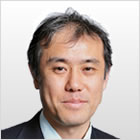Tsuyoshi Hasegawa

- Affiliation:
-
- Atomic Electronics Group, MANA, NIMS
- NanoSystem Functionality Center, NIMS
- Specialty:
- Nano-devices
- Academic degree:
- Ph.D. (science), Tokyo Institute of Technology (1996)
- Recent publications
- See NIMS Researchers DB
- Home Page:
- See Atomic Electronics Group, MANA, NIMS
Educational & Working History
| 2006 | Group Leader, National Institute for Materials Science (NIMS) | ||
| 2003 | Associate Director, NIMS | ||
| 2002 | Senior Researcher, NIMS | ||
| 1999 | Senior Research Scientist, The Institute of Chemical and Physical Research (RIKEN) | ||
| 1997 | Senior Researcher, Central Research Laboratory, Hitachi Ltd. | ||
| 1996 | Ph. D. in Physics, Tokyo Institute of Technology | ||
| 1987 | Researcher, Central Research Laboratory, Hitachi Ltd. |
Research History
He has been working on the surface science and the electronic devices. As a researcher of HCRL, he achieved atomic manipulation at room temperature using a scanning tunneling microscope (STM) to write atomic words, 'Peace 91 HCRL', for praying peace against Gulf Crisis. This was the first experiment in the world of manipulating a single atom in the surface layer. He also succeeded in dynamic observation of Si crystal growth with atomic resolution using STM. For carrying out these experiments, he developed original STMs with his coworkers. In Hitachi, he also worked on development of electronic devices, such as DRAM and Logic Devices. He developed a multi-probe STM combined with a scanning electron microscope (SEM) for failure analysis of the devices. His instrument has enabled direct measurement of a single semiconductor transistor formed on a chip, which drastically shortens the Turn Around Time (TAT) of the device development.
After moving to RIKEN, he returned to a fundamental research field, and started to develop multi-probe atomic force microscope combined with SEM. By using the instruments, he succeeded in observing switching phenomenon of nano-ionics device developed with his colleagues. The device is named Atomic Switch. He also succeeded in forming basic logic circuits using Atomic Switch. These successful experimental results and good enough performance of the device has been reported by NATURE in 2005. Collaboration with an electrical company has started to make practical device, which is expected to be commercially available in five years. He has conducted the research group of the Atomic Switch since 2003, with a supervision of Prof. Aono.
Selected Papers
-
- Conductance quantization and synaptic behavior in a Ta2O5-based atomic switch
- T. Tsuruoka, T. Hasegawa, K. Terabe and M. Aono
- Nanotechnology, 2012, 23, 435705.
-
- Atomically controlled electrochemical nucleation at superionic solid electrolyte surfaces electrolyte surfaces
- I. Valov, I. Sapezanskaia, A. Nayak, T. Tsuruoka, T. Bredow, T. Hasegawa, G. Staikov, Masakazu Aono and Rainer Waser
- Nature Materials, 2012, 11, 530-535.
-
- Atomically controlled electrochemical nucleation at superionic solid electrolyte surfaces electrolyte surfaces
- T. Ohno, T. Hasegawa, T. Tsuruoka, K. Terabe, J. K. Gimzewski and M. Aono
- Nature Materials, 2011, 10, 591-595.
-
- A polymer-electrolyte-based atomic switch
- S. Wu, T. Tsuruoka, K. Terabe, T. Hasegawa, J. P. Hill, K. Ariga and M. Aono
- Adv. Funct. Mater., 2011, 21, 93-99.
-
- Forming and switching mechanisms of a cation-migration-based oxide resistive memory
- T. Tsuruoka, K. Terabe, T. Hasegawa and M. Aono
- Nanotechnology, 2010, 21, 425205.
-
- Photo-assisted formation of an atomic switch
- T. Hino, H. Tanaka, T. Hasegawa, M. Aono and T. Ogawa
- Small, 2010, 6, 1745-1748.
-
- Size tunable UV luminescent silicon nanocrystals
- N. Shirahata, T. Tsuruoka, T. Hasegawa and Y. Sakka
- Small, 2010, 6, 915-921.
-
- Learning abilities achieved by a single solid-state atomic switch
- T. Hasegawa, T. Ohno, K. Terabe, T. Tsuruoka, T. Nakayama, J. K. Gimzewski and M. Aono
- Adv. Mater., 2010, 22, 1831-1834.
-
- A nonvolatile programmable solid-electrolyte nanometer switch
- S. Kaeriyama, T. Sakamoto, H. Sunamura, M. Mizuno, H. Kawaura, T. Hasegawa, K. Terabe, T. Nakayama and M. Aono
- IEEE J. Solid-State Circuits, 2005, 40, 168-176.
-
- Short-term plasticity and long-term potentiation mimicked in single inorganic synapses
- Terabe K, Hasegawa T, Nakayama T, Aono M
- Nature, 2005; 433, 47-50.


